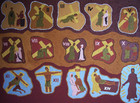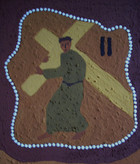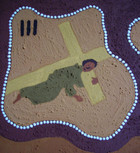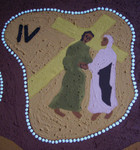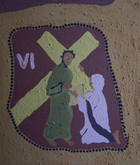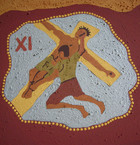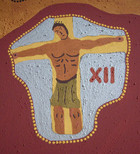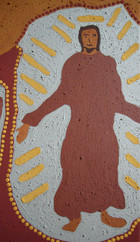Madelene Purdie
The barren, weather-eroded desert lands of Western Australia are rich in iron-oxides, a ready source of ochre colors for sacred art. Over tens of thousands of years, indigenous peoples stained the bones of their dead with red ochre, told “Dreaming’ stories about their cosmic origins in ochre paintings on rock and wood, and daubed ochre paint on their bodies for ritual ceremonies.
Set against this timeline, Aboriginal sacred art retelling the great narratives of Christianity in paintings with ochre-based pigments is still in its infancy, but this new genre, mixing cultures, beliefs, and artistic traditions, has found skilled practitioners in Shirley Purdie and her daughter, Madelene. Along with Madigan Thomas, their mother and grandmother, they represent something of an artistic matriarchy among the Kitja (Gidja) people, settled around the town of Warum (Turkey Creek) near the eastern boundary of the Kimberley region in Northwestern Australia.
The Kitja people of Warum have particularly close ties to the Roman Catholic Sisters of Saint Joseph, who established the Ngalangangpum Community School in the 1970s with the blessings of Kitja leaders to educate Aboriginal children, according to the “Two-Way” principle. Pupils study the Bible and Aboriginal Ngarrangkarni (Dreaming) narratives, learning Catholic dogma in the context of traditional Kitja beliefs. Shirley and Madelene Purdie have come to play an important part in this enriching, cross-cultural spiritual interchange though their imaginative translations of biblical themes into the symbolic language of ancient Aboriginal art.
The figurative cycle in Madelene’s Stations of the Cross conforms to the traditional European practice of showing Christ at 14 separate moments along the way to Calvary and adds a 15th image of the Resurrection, also in keeping with contemporary Western treatments of the theme. The overall composition with its amoebic-shaped narrative panels, bordered by white, black, and yellow dots, and those beautifully undulating stripes of brown, gold, and rust, so suggestive of the rugged landscape of the Kimberley region, is rooted in Kitja styles of ochre painting.
In taking on the Stations of the Cross, Madelene was following the lead of her mother, Shirley, whose treatment of the same subject was honored in 2007 with the Blake Prize for Religious Art, an Australian award for achievements in art dealing with spiritual themes.
